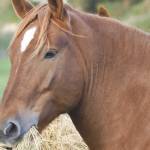Excess Weight and EMS Negatively Impact Horse Reproduction

Compared to other domestic animals like cows, ewes, and sows, mares have low fertility rates, largely due to higher rates of early embryonic death (EED). Although a number of factors influence mare fertility and EED—many of which have yet to be identified—excess body condition, which is commonly observed in horses with equine metabolic syndrome (EMS), contributes to the problem.
As recently reviewed by Theresa Burns, D.V.M., Ph.D., from The Ohio State University*, several issues should be considered when managing overweight broodmares with EMS. For example:
- Overweight mares, especially those with an underlying endocrine-associated lameness or laminitis, suffer orthopedic pain that is frequently difficult to control during the third trimester when the foal is rapidly growing;
- Foals born to overweight mares anecdotally appear to have more difficulty nursing due to excess fat tissue in the mammary glands, making the teats less prominent;
- Excess body condition, body fat, and abnormal hormone levels (e.g., elevated insulin and leptin, both of which occur in overweight horses with EMS) appear to contribute to a prolonged ovulatory season, with many mares failing to normally enter seasonal anestrous;
- Mares with EMS-associated insulin resistance (IR) had prolonged periods between heat cycles; and
- Mares with EMS had higher circulating levels of pro-inflammatory mediators, including interleukin-1 and tumor necrosis factor, which could contribute to the age-related decline in mare fertility.
“Clearly, maintaining your broodmare at an inappropriately elevated body condition score and failing to manage their endocrine health negatively affects reproductive performance in a species that already presents breeding challenges,” noted Kathleen Crandell, Ph.D., an equine nutritionist for Kentucky Equine Research.
According to both Burns and Crandell, suggested strategies for managing broodmares with EMS include special attention to diet, exercise, and management of laminitis.
- Offer a grass hay with <10% nonstructural (water-soluble) carbohydrates;
- Provide a ration balancer to ensure all dietary trace minerals are adequate or supply the minerals through a well-formulated vitamin and mineral supplement like Micro-Max (for Australian horse owners, choose Gold Pellet);
- Avoid overnutrition before, during, and after gestation but be careful trying to induce weight loss in an already pregnant mare; and,
- When supplemental feed is required later in gestation, offer a high-fat, high-fiber concentrate, rather than one laden with starch.
*Burns, T.A. 2016. Effects of common equine endocrine diseases on reproduction. Veterinary Clinics of North America. Equine Practice. 32(3):435-449.








